Newsletter 103 from 08/06/2008International Building Exhibition (IBA) Fürst-Pückler-Land1. Opened: Lauchhammer bio-towers emerge with renewed splendour |
|||||
(1) Opened:Lauchhammer bio-towers emerge with renewed splendourThe bio-towers in Lauchhammer were officially opened on 17 July after their makeover. Building Minister Reinhold Dellmann, Minister for Scientific Affairs Johanna Wanka and some 300 guests were present for the inauguration of the imposing industrial monument. The towers are all that remains of the former Lauchhammer coking plant. The towers have been enjoying a radical 1.4 million euro face-lift since 2006 and the surrounding landscape has been redesigned. The bio-towers have now been given a new lease of life as a place of remembrance and a venue for cultural events. The Ministers acknowledged the commitment demonstrated in the campaign for the preservation of the industrial plant and the courage displayed in seeing a challenging project through to completion. Following the speeches the bio-towers were opened with a “balancing act” performed by a group of tightrope artists called the “Trabers”. Visitors had the opportunity to climb one of the six groups of towers. It has been converted to a lookout with two viewing turrets, one at a height of 16 metres and the other at 19 metres. The Lauchhammer lignite heritage association “Traditionsverein Braunkohle Lauchhammer e.V.” is operating discovery tours on the site every Saturday and Sunday from 10 to 18 hrs. 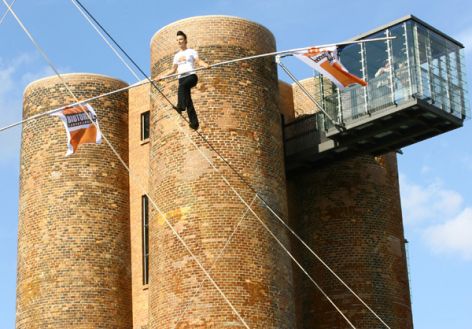
|
|||||
|
Photo: Rasche |
|||||
(2) Constructed:Floating houses built by schoolchildren for Lusatian Lakeland“Cast off and ahoy!” was the cry heard last weekend on Lake Gräbendorf when two floating houses were launched by 14 young people on the IBA raft building camp. The school-age children worked hard for ten days on the bed of Lake Ilse in Großräschen building two rafts out of plastic tubes, plastic bottles and piles of wood which were supposed to be strong enough to support a house. They worked as a team on the design and construction and managed to get the 750-kilogram crafts waterborne. The youngsters have thus gained hands-on experience of the challenges of floating architecture in the Lusatian Lakeland and also learnt something about themselves in a careers guidance workshop. The rafts have now taken pride of place on Lake Grabendorf where they will be used by diving school owner Gunther Walter and made accessible to visitors. The IBA would like to thank the Schülerakademie Lausitz, Z.E.I.T. GmbH, the Wasserverband Lausitz (WAL), Vattenfall Europe Mining & Generation AG and the Ministry of Education, Youth and Sport of the State of Brandenburg for their support. 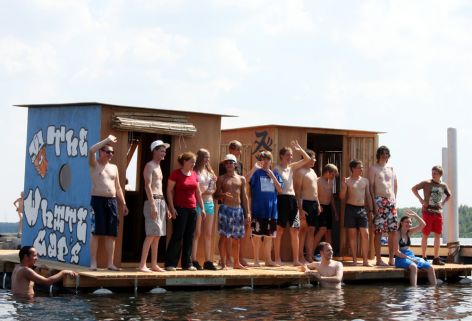
|
|||||

(3) Submitted:Feasibility study opens up prospects for floating bridgeThe sinai. planning agency recently presented the feasibility study on the floating bridge commissioned by the IBA and the Berlin-Brandenburg Joint Regional Planning Department. It shows that it is technically possible to build a 1000 metre long floating bridge across Sedlitz Lake. It also details different ways of going about it and the funds required for the IBA vision to become reality. The State of Brandenburg intends to assess before the end of 2008 whether the project ought to be eligible for funding. The floating bridge is to link the eastern and western shores of Sedlitz Lake and to become a tourist attraction in the Lusatian Lakeland. It is expected to offer docking locations for restaurants and a jetty for boats. It would be necessary to build a bridge to allow ships to negotiate the lake in order to gain access to other lakes via canals. |
|||||
(4) Announced:“Mobile floating architecture” competitionThe IBA Fürst-Pückler-Land has announced an open design competition on “mobile floating architecture”. The idea is to design a floating house which can be used as a holiday home or dwelling in the emerging Lusatian Lakeland. The brief also stipulates that the properties should attain maximum levels of self-sufficiency and mobility so as to be able to remain on the water as independently as possible of the supply infrastructure. The design should epitomise life on the water. The deadline for submitting designs is 15 September 2008. The relevant information and the terms and conditions for entering the competition are available for download on the IBA website. |
|||||
(5) Documented:Construction work proceeds on Lusatian Lakeland landmarkSince the foundation stone was laid in May for the 30-metre high viewing tower at the mouth of Sorno Canal, the edifice is now beginning to grow. The steel parts have been delivered and the building work is advancing. It is scheduled to open in October and to symbolise the transformation from mining landscape to lakeland as well as acting as a token for the development of the network of lakes in the Lusatian Lakeland linked by navigable waterways. The design is the work of architectural firm Giers Architektur & Landschaft and originated from an international competition run by the IBA and the town of Senftenberg in 2005. The Corten steel edifice will take on an atmospheric reddish-brown patina through exposure to the elements and will provide a magnificent view of the surrounding lakes. 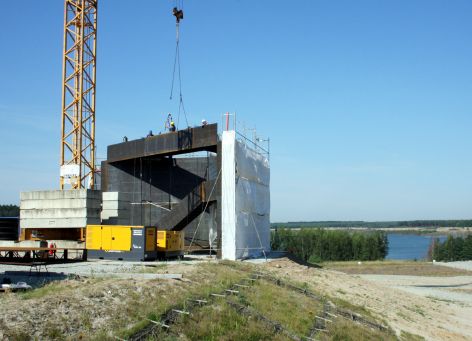
|
|||||
(6) Noted:Round table discussion “Why the need for a Water-Realm Spree?”The IBA is running a public round table on 21 August as part of the “aquamediale” art project where the subject for discussion will be “Why the need for a Spree water empire?” It will be held at 19:00 hrs in Lübben town hall. The discussion is being held in the light of plans to set up a Water-Realm Spree visitor centre in Lübben which would be an information centre with national impact and with an emphasis on excitement and adventure. Topics taking centre stage will be the biosphere, water management, climate change and sustainable development along the river Spree. The discussion is expected to look at the extent to which the project can help boost the region’s economic power and extend the amount of time visitors spend in the region. The panellists are Thomas Kohler, the Director of Müritzeum gGmbH, IBA Director Rolf Kuhn, and the Brandenburg Minister for Scientific Affairs Johanna Wanka. |
|||||
(7) Supported:ENERGY Route with great appeal and potential for developmentThe marketing strategy for the ENERGY Route through Lusatia’s Industrial Heritage commissioned by the IBA and the tourism syndicate was recently presented by an international group of students from the Willy Scharnow Institute for Tourism of the FU Berlin. According to their survey of visitors, the name meant something to one in three visitors although it has been in existence for just one year. Visitors cited the F60, the Schwarze Pumpe power station, the IBA Terraces and the Welzow-Süd open-cast mine as the most frequently visited locations. According to those surveyed, the main attractions of the places were the imposing nature of the buildings, the focus on the theme of energy, and the special guided tours and events. Potential for development was seen in greater cooperation with the relevant partners, coordinated public relations, and in the supply of catering establishments. This situation was taken as a basis for the development of strategies and innovative product ideas, the implementation of which will be discussed at the tourism syndicate’s conference. The idea of coordinated theatre performances has already aroused great interest. |
|||||
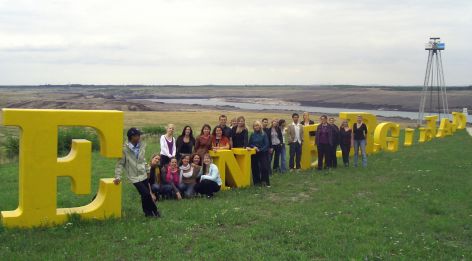
|
|||||

(8) Requested:Papers for 2009 TICCIH CongressThe “call for papers” for the world congress on the conservation of industrial heritage run by the International Committee for the Conservation of the Industrial Heritage - TICCIH for short - has been issued with a deadline of 30 November 2008. The conference will be held in East Germany for the first time from 30 August to 5 September 2009. The invitation to the Saxon city of Freiberg for scientific exchange is being issued by the Institute for History of Science and Technology of the TU Bergakademie Freiberg, the TICCIH National Committee for Germany, the Industrial Museum of Saxony, and the IBA Fürst-Pückler-Land. In its choice of venue the TICCIH is acknowledging not only the significance of Saxony and Lusatia as regions with an industrial past, but it is also recognising the efforts to preserve the industrial heritage and industrial monuments in East Germany. The main focus of the triennial conference will be “Industrial Heritage - Ecology - Economy”. The aim is to discuss the relationships between these themes and to identify new ways of working together. |
|||||
|
[h1( 9) Inaugurated:] Guided cycle tour along IBA sand path to Cottbus BalticThe IBA joined forces with the Kunstmuseum Dieselkraftwerk Cottbus to develop a “sand path” as part of the exhibition entitled “[Märkischer] Sand” [[Mark Brandenburg] sand], and this path was recently inaugurated in the presence of 40 interested cyclists. The cyclists enjoyed insights into the geology of Lusatia on the 20-kilometre circuit. Curator Jörg Sperling drew parallels with the works in the exhibition and IBA project manager Brigitte Scholz passed on information about the plans for the Cottbus Baltic which is scheduled to emerge by 2030 when the open-cast mine will have been flooded following the cessation of coal extraction. The cycle through time incorporates six stops and will be repeated on 31 August and 28 September. The tour starts at 10:00 hrs. from the Kunstmuseum Dieselkraftwerk Cottbus. 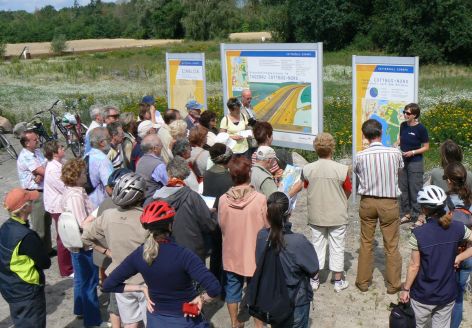
|
|||||

10) Promising:Sustained collaboration on the Gubin Parish Church projectThe partners of the IBA project Frankfurter Straße/Gubin Parish Church recently visited the IBA. These included representatives of the Gubin Parish Church Polish-German Meeting Place, the support association for the restoration of the church, and representatives of the town councils and of the historic monument preservation authority. The President of the Spree-Neisse-Bober Euroregion, Mr Fiedorowicz, and the President of the University of Zielona Góra, Mr Osêkowski, were also briefed on further IBA projects. There is a willingness to campaign together for the restoration of the church ruins and to work on a strategy for alternative use as a European meeting place. There are also plans to launch an architectural competition. “The gathering shows interest in the success of the project and also indicates cooperation”, said IBA project manager David Lang. There will be a first celebration of meeting together on 30 August, when the summer farewell concert will be held from 17:00 hrs. in front of Gubin Parish Church. The open-air event is free of charge and is being organised by the Kulturhaus Gubin arts and leisure centre. |
|||||
(11) Recommended:2nd IBA Film Nights on the bed of Lake IlseThe IBA will be putting on the "2nd Film Nights on Lake Ilse" from 22 to 24 August in cooperation with the Cottbus Film Festival. Movie fans will be able to experience a cinematic journey extraordinaire through the Czech Republic, Germany and Poland at the foot of the IBA Terraces. After a musical prelude, there will be a popular summer movie showing on the giant screen at 21:00 hrs. on all three evenings under a starry sky. All the films have one thing in common in that they are excellent social satires which turn the spotlight on certain people with sensitivity, subtlety and wit - be it at a traditional Polish wedding, daydreaming in a Berlin tower block housing estate or among the returnable bottles in a Prague supermarket. The films which will be showing are the Czech comedy “Empties”, the German tragicomedy “You are not alone” and the Polish cinema hit “The Wedding” (Wesele). |
|||||

(12) Spellbound:Summer theatre at Slavonic fortress captivates visitorsThe Slavonic fortress of Raddusch is one of the first IBA projects and celebrates its fifth anniversary this year. The early medieval refuge is putting on a special anniversary programme to attract visitors to the celebrations. The 2nd summer theatre season put on by the Sorbian National Ensemble Bautzen from 20 to 24 August is a really special highlight. The ballet opera “KRABAT or the Creation of the World” is on the programme on 20 and 21 August. The “Krabat” is an ancient Lusatian legend which featured mainly in magical fables and stories until the 1970s. Sorbian writer Jurij Brezan has updated the material and given it a “Faustian philosophy” twist. Dramatic advisor Wolfgang Rögner has adapted the novel into a ballet opera production. The dance opera “Year of the Kings” will be performed from 22 to 24 August. The production is based on the mythology and legends of the “seven Kings”. Both performances begin at 20.30 hrs. |
|||||
| go back | |||||
last update: 1/26/2017 13:13 |
|||||
